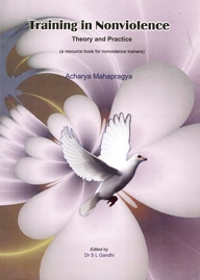Acharya Tulsi began to perform various kinds of experiments after propounding anuvrat (basic vows). He placed before myself and also before the whole nation and society, very important things and said that mere principles do not yield any good. A principle can be laid down, it can be listened to because it is good to hear, but it is forgotten soon. Even science has proved, that if a thing is confined to the conscious mind it does not last long. The entire mechanism of change lies in the unconscious mind. The potentiality of bringing about a change exists in the unconscious. A thing that doesn’t permeate the self and fails to reach the unconscious mind is not followed and implemented in practical behaviour. It is for this reason that it is very necessary to experiment and to train in nonviolence. In the course of our Ahimsa Yatra we carried out different kinds of experiments in this area.
If we can apply the theory of ahimsa to our practical life and undergo training in ahimsa, verbal discussions will be reduced and we will see more examples of enlightened behaviour. In verbal or theoretical nonviolence we only have lectures, teaching, discourses and theories. For hours there are continuous and fluent speeches and discussions, but it all results in nothing. The main question is how to transform human consciousness. Its only answer is practice (experiment) and training. I deliver discourses before you, but it is not enough to listen to them. Both listening and not listening are equal unless a person goes deep into and ponders over what has been said and his heart and mind are awakened and inspired through practice.
What is most essential for building a good individual and a good society is the transformation of consciousness - which is not possible without practical exercises and training. Today we find that discourses, sermons and lectures are being delivered at thousands of places in the world. If these had been effective remedies by now half the population of the world would have been converted to the ascetic path. Nowadays religious discourses and narrations of anecdotes and tales from sacred literature by sadhus and sannyasis are taking place at many places regularly. You may have a survey conducted by any reputed and credible agency to gauge the impart resulting in a qualitative change in the thinking and attitudes of the people of that area. I think you will be only disappointed when you hear the result. What is surprising is that those who spend the whole day struggling to earn their daily bread do not talk of ahimsa. It is those who are enjoying heavenly grandeur and magnificence that talk of ahimsa. The swamis, who own air-conditioned ashrams, walk on velvet carpets and are unaccustomed to putting their feet on the thorny and rough roads, talk much of ahimsa and of the people drowning in samsara (ocean of suffering) and burning in the fire of hunger. One fails to see harmony or concord within their life.
 Acharya Mahaprajna
Acharya Mahaprajna

